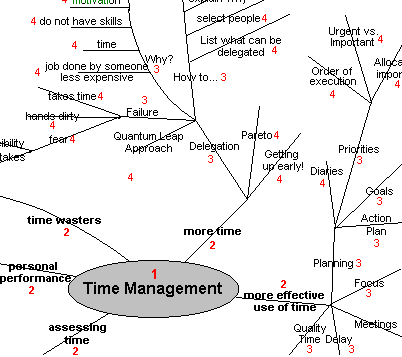|
 Appreciation Appreciation  Improved reading strategies Improved reading strategies
Improving Note Taking with Concept MapsConcept Mapping is a very important technique for noting information that is a significant improvement on conventional methods. Why use Concept Maps?Concept Maps abandon the list structure of conventional note-taking completely in favour of a two dimensional structure. A good Concept Map shows the 'shape' of the subject, the relative importance of information and ideas, and the way that information relates to other information. Typically Concept Maps are more compact than conventional notes, often taking up one side of paper. This helps associations to be made easily. Information that is acquired after the main Concept Map has been drawn can be easily integrated with minimal disruption.Concept Maps can also be used well to summarise information, to consolidate information from different research sources, to think through complex problems and as a way of presenting information that shows the overall structure of your subject. Concept Maps are also very quick to review - it is easy to refresh information in your mind just before it is needed by glancing at one. For people who have spatial memories, Concept Maps can provide effective mnemonics - remembering the shape and structure of a Concept Map can provide the cues necessary to remember the information contained within them. Concept Maps engage much more of the brain in the process of assimilating and connecting facts than conventional notes. Drawing Basic Concept MapsMind Tools Time Management section was planned and researched using Concept Maps. The Concept Maps used are too large to publish here, however part of one is reproduced below:  NB: Limitations in the drawing package used have restricted this example to horizontal text. To show how the Concept Map above was constructed, we have numbered the order in which lines were drawn. A basic Concept Map is drawn in the following way: - Write the title of the subject in the centre of the page, and draw a circle around it.
- For the first main heading of the subject, draw a line out from the circle in any direction, and write the heading above or below the line.
- For sub-headings of the main heading, draw lines out from the first line for each sub-heading, and label each one.
- For individual facts, draw lines out from the appropriate heading line.
A complete Concept Map may have main topic lines radiating in all directions, with sub-topics and facts branching off from these, like branches and twigs from the trunk of a tree. You do not need to worry about the structure produced - this will evolve of its own accord.Improving your Concept MapsYour Concept Maps are your own property. Once you understand how to assemble the basic structure you can develop your own coding and conventions to take things further, for example to show linkages between facts. The following suggestions, however, may help to enhance the effectiveness of your Concept Maps:- Use single words or simple phrases for information:
the majority of words in normal texts are padding - they ensure that facts are conveyed in the correct context to another person in a format that is pleasant to read. In your own Mind Maps single strong words and evocative phrases can convey the same meaning. Excess words just clutter the Concept Map, and take time to write down. - Print words:
joined up or indistinct writing can be more difficult to read and less attractive to look at. - Use colour to separate different ideas:
this will help your mind to separate ideas where that is necessary, and helps visualisation of the Concept Map for recall. Colour also helps to show organisation. - Use of symbols and images:
Where a symbol means something to you, and conveys more information than words, use it. Pictures help you to remember information. - Use shapes, circles and boundaries to connect information:
these are additional tools to help show the grouping of information. - Use arrows to show cause and effect
SummaryConcept Maps provide an extremely effective method of taking notes which shows the structure of a subject and the relative importance of facts and ideas in addition to the facts themselves. Concept Maps help to associate ideas and make connections that would otherwise be too unrelated to be linked.If you do any form of research or note-taking, try experimenting with Concept Maps. You will be surprised by their effectiveness. |

